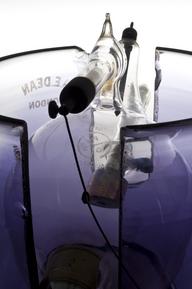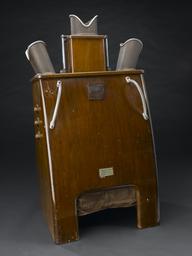35mm cine-film loop projector (including facility for magazine)
35mm cine-film loop projector (including facility for magazine), with variable speed control and with canvas cover, c.1951
In 1951, this machine exhibited in the Dome of Discovery at the Festival of Britain on London’s South Bank. It was presented as an example of ‘the technical progress in the British X-ray industry’. It allowed Watson & Sons to showcase this complex cineradiography set. The set consists of a 35mm cine camera, projector, X-ray tube, a patient’s couch and a radiographer’s stool. Only two machines of this type were manufactured. This one was used as a diagnostic tool at the Chemical Defence Establishment at Porton Down, Wiltshire. The machine films joint or lung movement. It can also monitor a barium meal as it moves around the body. A physician or radiologist replays the film to make a diagnosis. The machine was developed in collaboration with Dr Russell J Reynolds (1880-1964) who pioneered the use of cineradiography from 1921.






